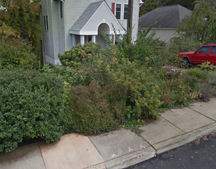
At a glance
Complexity |
Cost |
Easy / Moderate |
$3/square foot for do-it-yourself |
Quick note!Rain barrels or other rainwater harvesting systems complement these practices very well. When placed under a downspout, uphill from the landscape, they offer an inexpensive and convenient way to provide temporary “ponding” to deliver more water to the Conservation Landscape over a period of up to two days. |
Selecting the Theme
The plant type will determine both the aesthetic character of your conservation landscape and the level of effort required for maintenance. Below are the options presented in this tool.
 |
Simple MeadowDescription: A mixture of grasses, sedges, and flowering perennials, may grow 1-3’ tall. |
 |
Flowering Tree Focal PointDescription: Similar to the Simple Meadow above, but with a flowering tree as the focal point and the grasses and perennials accentuating it, with potential shrubs for balance. |
 |
Typical KidneyDescription: A mixture of trees, shrubs, and herbaceous plants (grasses, sedges, flowering perennials). |
 |
Woody ScreenDescription: Shrubs, and a tree for larger landscapes, providing a denser visual screen once established. |
 |
Butterfly GardenDescription: A mixture of flowering perennials and shrubs, providing important pollinator habitat. Expect butterflies, and bumble bees! |
Location, Sun/Shade and Soil Conditions
The amount of sun you get, how quickly your soils drain after a rain, the slopes of your yard, and the relative location of your house and driveway (impervious surfaces) to the low point on your property are all factors that affect the design choices for your practice. Click here for the full Site Assessment guidance . The basics are presented here also.
The basics are:
- Is there an area in the yard where you can install a landscape practice, preferably downhill from the impervious surfaces like the house’s downspouts, driveway, sidewalk, and deck? (This is where it will do the most good.) If the answer is no, you may wish to look at other practices, like rainwater harvesting, but conservation landscapes will do some good anywhere.
- Is the location where you intend to install the Landscape in the sun most of the day, part of the day, or is it mostly in the shade?
- How much space do you have available for your practice?
Note: While a conservation landscape can be any size, and is beneficial at any size, if it is big enough to capture one inch of rainfall from the impervious surfaces uphill from it, it will be very effective at improving water quality.
First, if you can, it’s best to locate the conservation landscape downhill from your impervious surfaces so it can catch the runoff from them. A rain barrel will also help feed more water to your conservation landscape from your roof after a rainfall. The Site Assessment appendix and Conservation Landscape chapter of the Rainscaping Manual will help guide you in how to locate the installation.
Sizing Your Conservation Landscape
You may have a particular area that is already designated for your new conservation landscape practice, or you may be deciding that. If you know the area of the practice, great! If not and you would like to calculate the size based on ideal water quality treatment, you can find some guidance by clicking here.
